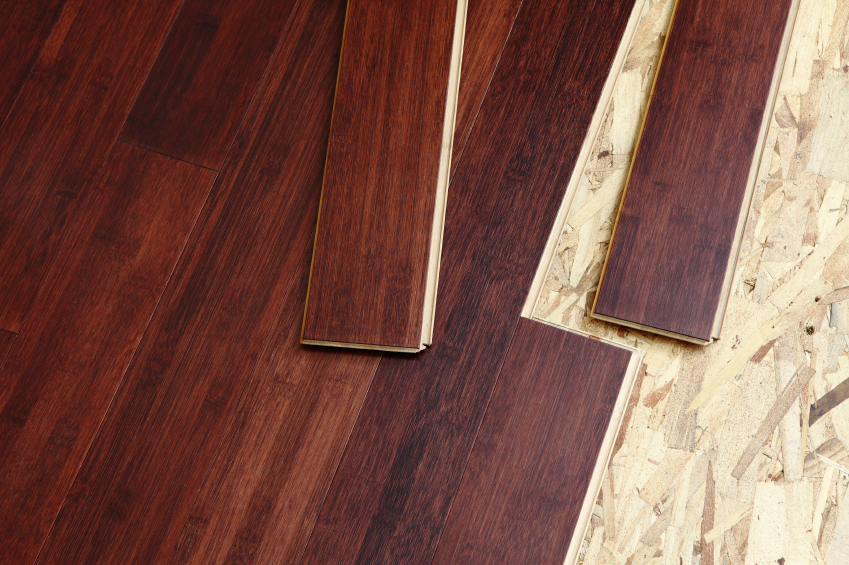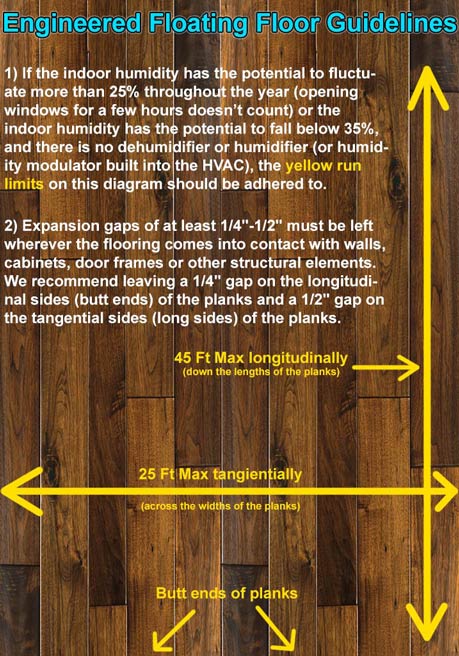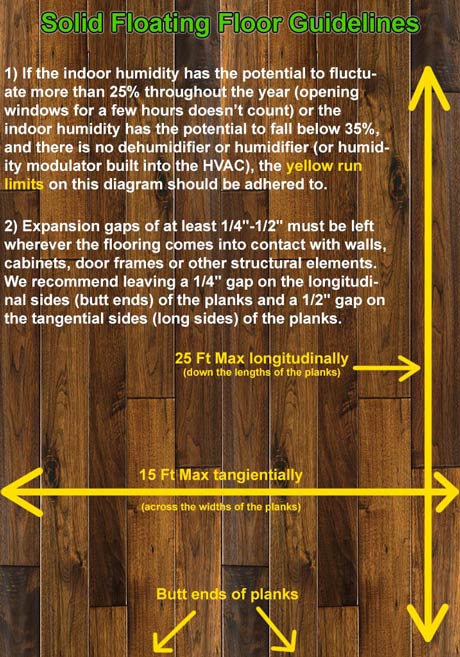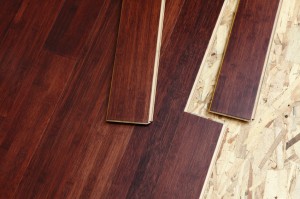 More and more homeowners consider bamboo flooring for their homes because of its rapid renewability, toughness, and affordability. When it comes to shrinkage, there’s a lot of misinformation (and confusion) on the internet, and there’s a wide range of experiences had by different homeowners across the globe. In this article, we will provide you with accurate information about how to choose, install, and maintain bamboo floors that will give you trouble-free use for years to come.
More and more homeowners consider bamboo flooring for their homes because of its rapid renewability, toughness, and affordability. When it comes to shrinkage, there’s a lot of misinformation (and confusion) on the internet, and there’s a wide range of experiences had by different homeowners across the globe. In this article, we will provide you with accurate information about how to choose, install, and maintain bamboo floors that will give you trouble-free use for years to come.
As with any other durable good you purchase, do your homework! Start in the right direction by investing about 30 minutes of your time researching the bamboo flooring brands/companies you’re considering by looking for reviews and complaints on the internet. Several high-quality bamboo flooring options are also affordable (think $3-$5/square foot) if you find a company specializing in bamboo; these prices stack up very favorably against traditional wood floors. Some brands are known for shrinkage, so be on the lookout. From then on, it’s all about making the right bamboo flooring choice for your home, setting up bamboo flooring installation, and then maintaining it correctly.
If you choose the right brand and the floor is installed and maintained correctly, you will be rewarded with a beautiful, stable, and extremely long-lasting and eco-friendly floor! And don’t forget, always make sure your installer reads the installation instructions before beginning the project. Below are some common reasons why homeowners have expansion and contraction problems with their bamboo floors (and all wood floors) in general.
Not Acclimating The Floor Properly
All wood and bamboo floors must acclimate before installation. High-quality bamboo brands can be acclimated in as little as 72 hours, whereas lesser quality brands may require a couple of weeks to acclimate. It’s generally recommended that you allot for additional days when acclimating in a very high or low humidity geographical location. Finally, always read the manufacturer’s directions about how/what/when, and where of acclimation.
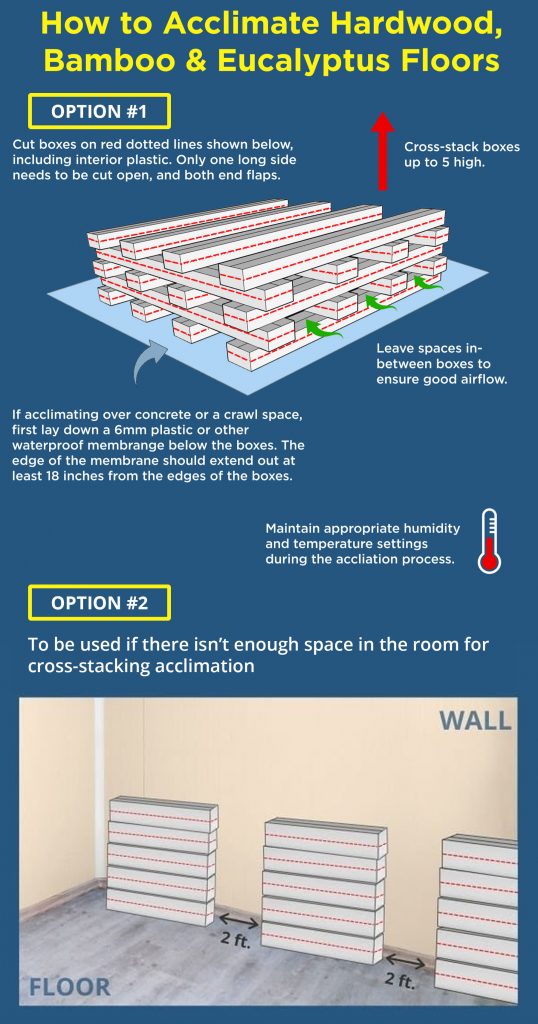
Choosing The Wrong Brand
Wet Bamboo. When bamboo flooring is manufactured, there is a drying and moisture-balancing period (before milling) that is crucial to the flooring’s dimensional stability. Unfortunately, some companies rush their products to market, failing to dry the flooring for the requisite period. Lower quality brands improperly moisture-balance their floors, resulting in “wet” bamboo floors, which will lose their moisture over time and begin to shrink (especially in the wintertime).
Run Limits Not Specified In The Installation Instructions. The floors that are most likely to experience shrinkage problems are solid FLOATING bamboo floors. These floors have often been either A) improperly moisture-balanced and/or B) sold to customers without informing them upfront about humidity requirements. There are potential problems with these floors in variable humidity conditions (more on this below).
As with any other large purchase you make, when you look to buy bamboo flooring it’s always smart to search for reviews or complaints on the web about the brands you’re considering from real review sites or online message boards.
Exceeding The Maximum Recommended Runs
If you’re nailing or gluing down your floor, live in a climate with stable year-round humidity, or have a built-in humidity control system that will keep your interior humidity within a 20% range year-round, the maximum run limitations outlined below probably don’t apply to you.
In environments where the humidity varies more than 30% in any given year, solid floating bamboo floors have limits to the successive “runs” they can be laid in. A “run” refers to the maximum continuous distance your floor can be laid before you have to stop the floor, install a molding (most often at-mold), and then continue the floor on the other side of the molding or breakpoint. These breakpoints minimize the contraction effects from multiplying over long distances that result in separation from walls and gapping.
- When nailed down or glued down, Tongue and groove bamboo flooring have no run limit – your “runs” can go on forever (better than it sounds;o).
- Engineered click lock bamboo flooring requires breakpoints at 25 feet across the planks’ widths and 40-45 feet down the planks’ lengths.
- Solid click lock bamboo flooring requires breakpoints at 15 feet across the planks’ widths and 20-30 feet down the planks’ lengths.
** As a rule of thumb, long runs of flooring should always be glued or nailed down **
SOLID TONGUE & GROOVE FLOOR (is nailed or glued down)
PROS
- Solid wood can be refinished up to 5 times.
- No limit in the distance of continuous runs of this floor when nailed down or glued down.
SOLID CLICK-LOCK BAMBOO FLOOR (is “floated”)
PROS
- Solid wood
- It can be refinished up to 5 times.
- Easy installation
CONS
- Increased shrinkage effect when humidity levels decrease by 20% or more
- Maximum recommended runs if stable indoor humidity cannot be maintained: 15 ft across widths (tangentially) and 25 ft lengthwise (longitudinally)
ENGINEERED CLICK-LOCK BAMBOO FLOOR (is “floated”)
PROS
- High dimensional stability
- It can be refinished up to 2 times.
- Easy installation
CONS
- Maximum recommended runs if stable indoor humidity cannot be maintained: 25 ft across widths (tangentially) and 45 ft lengthwise (longitudinally)
WHEN YOU DON’T HAVE STABLE HUMIDITY – FOLLOW THE RUN LIMITS
Ignoring The Humidity In Your Home and Your Geographical Climate
If you live in a geographic location with stable year-round humidity or your HVAC system can maintain constant humidity levels, you are unlikely to experience shrinking floors (unless you don’t acclimate them properly). However, if you live in an area where the humidity varies more than 15% throughout the year (and you experience seasons), you’re much more likely to experience expansion and contraction in your wood and bamboo flooring (this is normal), and the effect is increased exponentially in solid floating wood/bamboo flooring.
Unless your home’s interior relative humidity stays within the same 15-20% range year-round, it’s always recommended to install a solid tongue and groove floor via a nail down or glue-down installation. Low interior humidity settings are a common cause of bamboo and wood floor shrinkage.
Floating a Solid Wood or Bamboo Floor – Know The Limitations
Like Hary Callahan said: “A man’s got to know his limitations.” All bamboo and wood expands and contracts in response to humidity. When floor planks are nailed or glued down to the sub-floor, each plank will expand and contract a tiny amount. This is normal wood flooring behavior and causes small gaps to develop between planks in the winter. Conversely, floating floors (where planks are all locked together but not secured to the sub-floor) will expand and contract as one entire unit. Each plank expands and contracts, but since no tiny gaps form between the planks (because they’re locked into each other and not secured to the subfloor), these expansion/contraction forces get pushed outwards (radiates out) to the outer edges of the installation.
Now picture a consecutive run of 100 planks all clicked together and floating as one piece. If each plank contracts by just 1 mm, a massive shrinkage effect radiates out to the edges of the installation. After a few seasonal cycles of this effect, floors can separate from outer walls, and planks can separate in the middle of rooms. When this happens, eventually, the whole floor needs to be taken up and re-laid, which can be a costly repair.
If you decide on solid FLOATING bamboo flooring, make sure you have stable indoor humidity. Otherwise, you’ll need to take preventative measures to ensure your floors don’t shrink, such as having a break in your floor every 15 feet (use at-molding where possible). This step minimizes the radiating effect on your floors’ perimeter and subsequent pulling away from walls and gapping.
Mind the Expansion Gap
And speaking of gapping, it’s essential to remember during installation to leave a space (gap) of at least 1/4 to 1/2 inch around the perimeter of your floor. Many DIYers don’t realize that this also means, for example, installing bamboo flooring in kitchens around solid fixtures like the kitchen island and columns, not just the obvious walls in the room. So think of it this way, the gap should be left along all vertical surfaces in the room. Once the floor has been installed (What is the cost to install bamboo flooring?), this gap will be hidden with decorative accessories like baseboards and shoe molding.
IN SUMMARY
- Choose a high-quality bamboo flooring brand (do your homework!).
- If you live in an area with dry winters and humid summers (or vice versa) and don’t have interior humidity control, you should nail down or glue down the floor instead of floating it. If your runs are less than 15 ft wide X 25 ft long, you can probably float the floor, but it’s still a risk.
- Acclimate the floor properly, as per the manufacturer’s guidelines. If you’re in a dry or humid geographical area, add on 3-4 days extra for acclimation.
- Install the floor as per the installation instructions.
- Maintain stable year-round humidity in your home, between 40%-60%.
Want To Avoid Shrinkage? Consider Engineered Click Lock Bamboo Floors or Tongue And Groove Bamboo Floors
Engineered bamboo flooring consists of multiple layers that offer 3x as much dimensional stability as solid wood floors. If you live in a climate with humidity changes from winter to summer, you’ll want to choose this type of floor over a solid wood click lock product. Installing floating engineered bamboo flooring means you won’t have planks that pull away from walls after a couple of cold winters (as long as the recommended run limits are maintained).
How to Select a Reputable Bamboo Supplier

It would help if you always did your homework before choosing a bamboo brand to purchase from. Use online review sites and the Better Business Bureau to find a reputable supplier you can trust and whose products are of the highest quality.
Eco-Friendly and Affordable Flooring
If you’ve done any research on bamboo flooring, you know that it is environmentally friendly and usually costs less than traditional hardwood floors. Keep in mind that different suppliers have different standards for providing consumers with “green” products. If you’ve been thinking about installing bamboo floors in your home but have been worried about potential shrinkage problems, we hope this article has helped you understand a bit better than it’s the quality of the product and the type of installation that will determine how stable it is.
Since 2005, Ambient Bamboo Floors is proud to be a leading supplier of hardwood bamboo products. We are A+ certified by the Better Business Bureau and committed to customer service excellence and product quality. All of our bamboo floors come with a lifetime structural warranty and finish warranty. All of our bamboo products are engineered to meet only the highest standards. Our strand woven bamboo flooring has ratings that far exceed any hardwoods, so it’s ultra-resistant to denting, warping, and anything else an active family can throw at it! Our bamboo is harvested from properly managed forests that reach maturity within 5-7 years. We are a member of the US Green Building Council, and many of our products qualify for LEED credits. All of our bamboos come from FSC® certified forests. If you have to resist any questions, please contact us! Last update of the article: 01/27/2020
If you have to resist any questions, please contact us! Last update of the article: 01/27/2020
About the Author
James is your friendly neighborhood content writer here at the Green Living Blog. With a passion for all things sustainable, he’s your go-to guru for everything eco-friendly. Armed with a treasure trove of wisdom about sustainable living, recycling, and environmentally conscious practices, James is on a mission. He’s here to make sure you not only protect your family but also keep Mother Earth smiling. 😊🌎 When he’s not busy sharing eco-friendly insights, James can often be found teaching his cat that compost bins make the purr-fect hideaway. 🐱♻️ Join James on his quest to uncover the secrets of defeating wasteful habits while leaving the lightest footprint on our precious planet’s ecosystem.

